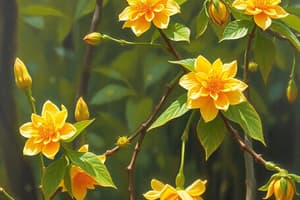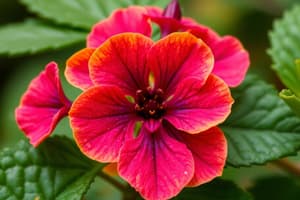Podcast
Questions and Answers
Which one of these is true about primary metabolites?
Which one of these is true about primary metabolites?
- They serve diverse functions within plants
- They are chemicals found in herbalism
- They are not important for the plant's survival
- They are essential for the survival of the plant (correct)
What is the estimated number of secondary plant metabolites discovered so far?
What is the estimated number of secondary plant metabolites discovered so far?
- Thousands
- 200,000 (correct)
- Hundreds
- 80-90%
What do secondary metabolites serve within plants?
What do secondary metabolites serve within plants?
- Fundamental functions
- Diverse functions (correct)
- Chemical functions
- Survival functions
What are secondary plant metabolites collectively referred to as in herbalism?
What are secondary plant metabolites collectively referred to as in herbalism?
What is the difference between primary and secondary plant metabolites?
What is the difference between primary and secondary plant metabolites?
What are examples of primary metabolites?
What are examples of primary metabolites?
What is the purpose of a herbal monograph?
What is the purpose of a herbal monograph?
Where can reliable herbal information be accessed?
Where can reliable herbal information be accessed?
What is the focus of phytochemistry?
What is the focus of phytochemistry?
How many primary and secondary plant metabolites are estimated to be undiscovered in herbalism?
How many primary and secondary plant metabolites are estimated to be undiscovered in herbalism?
Which of the following is NOT a function of plant constituents?
Which of the following is NOT a function of plant constituents?
Which class of constituents includes compounds like salicylic acid and flavonoids?
Which class of constituents includes compounds like salicylic acid and flavonoids?
What is the function of glycosides in plant constituents?
What is the function of glycosides in plant constituents?
Which solvent is most suitable for extracting alkaloids from plants?
Which solvent is most suitable for extracting alkaloids from plants?
What is the solubility of resins in water?
What is the solubility of resins in water?
Which factor does NOT influence the solubility of plant constituents?
Which factor does NOT influence the solubility of plant constituents?
Which of the following is NOT a major class of constituents?
Which of the following is NOT a major class of constituents?
What is the solubility of flavonoids in alcohol?
What is the solubility of flavonoids in alcohol?
Which of the following is a function of secondary metabolites?
Which of the following is a function of secondary metabolites?
Which class of constituents includes compounds like volatile oils and carotenoids?
Which class of constituents includes compounds like volatile oils and carotenoids?
True or false: Primary metabolites are essential for the survival of plants?
True or false: Primary metabolites are essential for the survival of plants?
True or false: Secondary metabolites serve diverse functions within plants?
True or false: Secondary metabolites serve diverse functions within plants?
True or false: Approximately 200,000 secondary plant metabolites have been discovered?
True or false: Approximately 200,000 secondary plant metabolites have been discovered?
True or false: The solubility of flavonoids is alcohol?
True or false: The solubility of flavonoids is alcohol?
True or false: Resins are soluble in water?
True or false: Resins are soluble in water?
True or false: Glycosides have a sugar unit attached to a phenolic compound.
True or false: Glycosides have a sugar unit attached to a phenolic compound.
True or false: Alkaloids are generally more soluble in water than in alcohol.
True or false: Alkaloids are generally more soluble in water than in alcohol.
True or false: Resins are insoluble in water but soluble in alcohol or oil.
True or false: Resins are insoluble in water but soluble in alcohol or oil.
True or false: Flavonoids have varying solubility depending on their glycoside.
True or false: Flavonoids have varying solubility depending on their glycoside.
True or false: Volatile oils are soluble in water but slightly soluble in alcohol.
True or false: Volatile oils are soluble in water but slightly soluble in alcohol.
Polysaccharides like inulin, arabinogalactans, and beta-glucans are examples of ______ in plants
Polysaccharides like inulin, arabinogalactans, and beta-glucans are examples of ______ in plants
Alkamides and fatty acids are examples of ______ in plants
Alkamides and fatty acids are examples of ______ in plants
Salicylic acid, coumarins, and flavonoids are examples of ______ in plants
Salicylic acid, coumarins, and flavonoids are examples of ______ in plants
Volatile oils, resins, and saponins are examples of ______ in plants
Volatile oils, resins, and saponins are examples of ______ in plants
Isoquinoline and pyrrolizidine are examples of ______ in plants
Isoquinoline and pyrrolizidine are examples of ______ in plants
Plants can contain hundreds to thousands of unique chemicals which include: Primary metabolites - fundamental to the life of the plant (e.g. proteins, lipids, carbs, chlorophyll). Secondary metabolites do not appear to be fundamental to sustain life but serve diverse functions within plants. ~200,000 secondary plant metabolites have been discovered. estimated that science has yet to uncovered 80-90% of them in herbalism are referred to as plant ______.
Plants can contain hundreds to thousands of unique chemicals which include: Primary metabolites - fundamental to the life of the plant (e.g. proteins, lipids, carbs, chlorophyll). Secondary metabolites do not appear to be fundamental to sustain life but serve diverse functions within plants. ~200,000 secondary plant metabolites have been discovered. estimated that science has yet to uncovered 80-90% of them in herbalism are referred to as plant ______.
Chalker-Scott, L. How Plants Work: The science behind the amazing things plant do. Portland, OR; Timber Press; 2015.
Chalker-Scott, L. How Plants Work: The science behind the amazing things plant do. Portland, OR; Timber Press; 2015.
By the end of this lesson, students will be able to: 1. Name primary and secondary plant metabolites and understand the difference between them 2. Classify herbal constituents and understand their solubility 3. Define and give herbal examples of herbal actions 4. List herbs with selected tissue affinities 5. Describe the herbal monograph as a learning resource and know how/where to access reliable herbal information in order to apply information to case presentations HERBAL CONSTITUENTS THE CHEMICAL PARTS WITHIN A PLANT PRIMARY & SECONDARY PLANT METABOLITES
By the end of this lesson, students will be able to: 1. Name primary and secondary plant metabolites and understand the difference between them 2. Classify herbal constituents and understand their solubility 3. Define and give herbal examples of herbal actions 4. List herbs with selected tissue affinities 5. Describe the herbal monograph as a learning resource and know how/where to access reliable herbal information in order to apply information to case presentations HERBAL CONSTITUENTS THE CHEMICAL PARTS WITHIN A PLANT PRIMARY & SECONDARY PLANT METABOLITES
True or false: Resins are insoluble in water but soluble in alcohol or ______.
True or false: Resins are insoluble in water but soluble in alcohol or ______.
Which solvent is most suitable for extracting alkaloids from ______?
Which solvent is most suitable for extracting alkaloids from ______?
Match the following plant constituents with their respective major class:
Match the following plant constituents with their respective major class:
Match the following constituents with the suitable solvent to extract them:
Match the following constituents with the suitable solvent to extract them:
Match the following constituents with the correct description of their solubility:
Match the following constituents with the correct description of their solubility:
Match the following constituents with their biological activity:
Match the following constituents with their biological activity:
Match these influences on constituent solubility with their correct descriptions:
Match these influences on constituent solubility with their correct descriptions:
Match the following terms to their definitions:
Match the following terms to their definitions:
Match the following learning objectives with their descriptions:
Match the following learning objectives with their descriptions:
Match the following terms to their definitions:
Match the following terms to their definitions:
Match the following terms to their definitions:
Match the following terms to their definitions:
Match the following terms with their definitions:
Match the following terms with their definitions:
Flashcards are hidden until you start studying
Study Notes
Primary and Secondary Metabolites
- Primary metabolites are essential for plant survival and include proteins, lipids, carbohydrates, and chlorophyll.
- Secondary metabolites, while not crucial for survival, serve diverse roles such as defense and attraction in plants.
- Approximately 200,000 secondary plant metabolites have been documented, with an estimated 80-90% yet to be discovered.
Functions and Classifications of Metabolites
- Secondary metabolites in herbalism are commonly referred to as plant constituents.
- Major classes of plant constituents include glycosides, alkaloids, flavonoids, volatile oils, resins, and saponins.
- Glycosides contain a sugar unit attached to a phenolic compound.
- Alkaloids like isoquinoline are less soluble in water compared to alcohol.
Solubility and Extraction
- The solubility of flavonoids typically occurs in alcohol.
- Resins are insoluble in water but soluble in alcohol or oil; they do not dissolve in water.
- The most suitable solvent for extracting alkaloids is alcohol.
- Factors affecting solubility include solvent type, temperature, and chemical structure.
Herbal Monographs and Reliable Information
- Herbal monographs serve as a learning resource, providing detailed information about plant constituents and their uses.
- Reliable herbal information can be accessed through reputable databases, publications, and academic resources.
Focus of Phytochemistry
- Phytochemistry focuses on the study of plant chemicals and their effects, classifications, and properties.
- Plants can contain hundreds to thousands of unique chemicals.
Examples of Plant Constituents
- Polysaccharides like inulin, arabinogalactans, and beta-glucans are considered primary metabolites.
- Alkamides and fatty acids are examples of secondary metabolites.
- Salicylic acid, coumarins, and flavonoids are also classified as secondary metabolites.
- Volatile oils, resins, and saponins are examples of plant constituents with specific functions.
True or False Statements
- True: Primary metabolites are essential for the survival of plants.
- True: Secondary metabolites serve diverse functions within plants.
- True: Approximately 200,000 secondary plant metabolites have been discovered.
- False: Resins are soluble in water.
- False: Alkaloids are generally more soluble in alcohol than in water.
- True: Flavonoids have varying solubility depending on their glycoside structure.
- False: Volatile oils are not soluble in water; they are slightly soluble in alcohol.
Studying That Suits You
Use AI to generate personalized quizzes and flashcards to suit your learning preferences.




